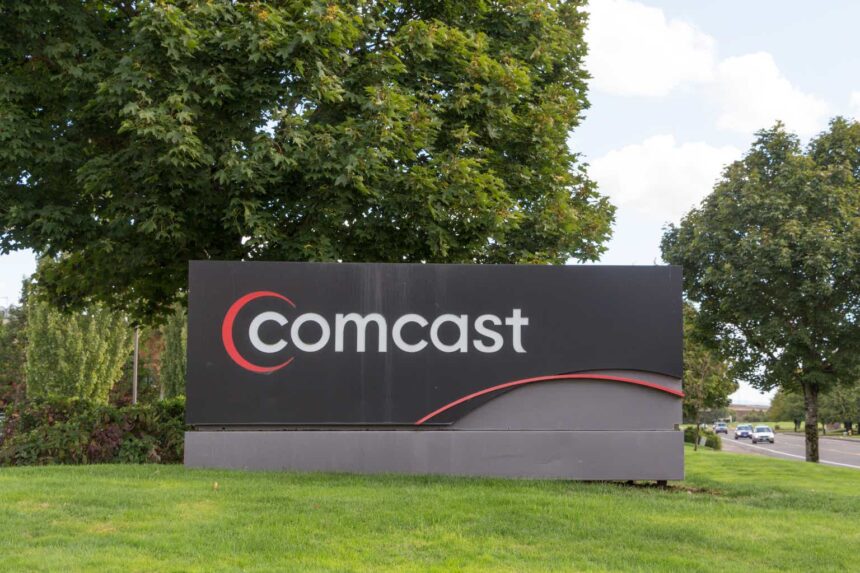
SweetBabeeJay
Well, I still can’t believe it, but it’s true nonetheless; the NBA will shortly be (nearly) tripling its annual rights fees.
The even more amazing thing is, that isn’t even the real headline; from the beginning, the NBA has been seeking nothing less than a tripling of its rights fees, and for a very long time the consensus among analysts was that the NBA would get it or something close to it. And now it has, by both doubling the per-deal fee it charges and by adding a third partner to the two it already has.
The more surprising news, however, is that Comcast’s (NASDAQ:CMCSA) NBCUniversal has stolen a march on David Zaslav’s Warner Brothers Discovery (WBD) and may be on the verge of restoring the NBA rights it lost in 2002, or at least a portion of them; Disney’s (DIS) ABC/ESPN remains the first partner of the league.
This has huge implications for both Comcast itself, as well as the pay-TV universe (what’s left of it) writ large. I am concerned that Comcast is setting itself up to take a real money-losing blow on this deal, and while its $151 billion market cap makes that something less than a lethal blow, the potential losses are larger than the market seems to be pricing in. And the mere fact that Comcast seems to be making more and more bad sports investments adds to a growing sense of unease about Comcast’s sports streaming strategy writ large.
Recent News Summary
Comcast has reportedly offered $2.5 billion a year to the NBA for the ‘B’ package of games, formerly belonging to Warner. That is more than a doubling of the $1.2 billion fee Warner was charging, and therefore already an excessively large increase. But it’s actually worse than that.
There is also the question of whether the ‘B’ package itself is quite what it used to be. Under the old two-contract paradigm, A and B each got a Conference Finals series and the ‘A’ package also got the NBA Finals. But now there are reports that Amazon’s (AMZN) ‘C’ package will also include a Conference Finals series, at least every other year. So did that come out of A’s (Disney’s) pocket or B’s? Well, supposedly, Disney’s deal continues to include both the Finals and a Conference Finals series so it looks like Comcast’s pocket got picked.
Assuming that Comcast is bidding for only half of a Conference Finals series, and really is offering to pay more than twice what Warner was paying, the first thing we have to ask is how in the world Comcast can ever expect to make money from this.
Analyzing The Deal
The problem with evaluating any sports rights deal is that it has to be looked at through two, almost alternate universe prisms: a streaming-only world where customers can decide for themselves whether to subscribe to the service that has the sports, and a linear world where everyone pays regardless of viewership.
Almost certainly, Comcast is making this offer because it thinks the linear bundle is going to survive to the end of the deal, or at least close enough to it that they can make their money back. Which, considering this is either a 10- or 11-year deal being proposed, is saying something. Even if they’re right about that, though, I question whether this possible reward justifies the risk. Namely, that the TV universe at large will shift to streaming-predominant over the life of the deal, since a streaming monetization path would be much deeper into the red than a linear one would be into the black.
Linear Universe
I have no idea how much of every cable bill is being allocated to the NBA, but one analyst did report that he thought Warner’s TNT would see carriage fees decline 45% if it lost the NBA.
Reports have TNT’s affiliate fee at $3 per subscriber per month. That is the second highest affiliate fee in cable-TV, trailing only the king himself, ESPN. At roughly 72 million pay-TV subscribers, that means that of TNT’s $2.6 billion in affiliate fees, almost $1.2 billion of it can be ascribed to its NBA deal. Presumably, that money would follow the NBA to its new home at NBC.
Broader Bundle Allocations
Frankly, I would have thought the number would be even more. And it may well be. One point that I’ve tried to make again and again is that cable/satellite companies care much less than content providers do how their money is broken down across the various channels they’re signing. To the distributor, all the channels from each content provider are being bought in a bundle, so the cost of the bundle is what matters, not the cost of each channel.
So it’s not entirely inconceivable that some of the money on TBS, truTV, Cartoon Network, perhaps even CNN is actually “NBA” money in the sense that even though its not part of TNT’s pay, distributors willingness to pay it is a reflection of the value of NBA, and the channels that carry it, bring. If that is the case, there is more than $1.2 billion at stake here for Comcast and Warner.
Advertising And Annual Escalators
Let’s assume, though, that $1.2 billion is all it is. Turner Networks also takes in about $600 million in NBA advertising money, so that comes to $1.8 billion or so. Well, that looks like a bad deal, but that is only the first year of the new deal. Not even, in fact, since the deal doesn’t kick in for another year and cable sports fees will be continuing to grow in the meantime.
I’ve discussed in prior articles how asymmetrical the compound growth rate is between sports fees paid from distributors to providers and those paid from providers to leagues. The former grow at a steady, higher rate, while the latter grow at a lower rate, buttressed by once-a-decade or so jumps as deals are renegotiated.
The $2.5 billion price that’s being reported is an average figure. What will be paid in year five or six of the deal. Generally, the bands on rights fees tend to be around 15% in either direction, so in year one NBCUniversal would presumably pay around $2.1 billion or so, rising to $2.9 billion in the last year of the deal.
Conversely, payments from distributors rise much more quickly. Assuming the linear bundle stays intact, that $1.8 billion could rise to $3.6 billion by the last year of the deal. At the average rate, then, Comcast is offering $2.5 billion for something that should pay about $2.7 billion.
I think the affiliate money all in comes to more than $1.2 billion. However, spreading the wealth over three deals instead of two will dilute the incoming cash somewhat, so let’s stick with a profit of a couple hundred million a year. Still not bad.
There’s profit there, and there’s probably more than that, since presumably Comcast would also get at least a few streaming subscribers from the non-pay-TV world as well.
Altogether, I’d call it about $300 million or so a year in profit if cord-cutting stopped tomorrow.
Streaming Universe
Look at this deal through a streaming prism, though, and things become much grimmer.
The NBA generates roughly 10% of the viewership per game that the NFL does. Granted, in the regular season it has more games, but no matter how many games you have a streaming service can only charge a subscriber once per month. More games boost ad revenue, but do not boost subscription revenue.
The right way to calculate is therefore to back out the advertising revenue first, then calculate the subscription revenue. We know the ads are $600 million. That means that Peacock, Comcast’s streaming service, would need about $1.5 billion in subscription fees to cover the cost of the deal in the first year.
Well, that’s just ridiculous. As I calculated when the NFL deals kicked in, Comcast’s break-even point for the NFL deal is $1 billion in subscription revenue – and Comcast loses money on that deal, almost certainly, despite having 10x as many viewers to charge fees to. $1.5 billion for the NBA is just nothing short of absolutely insane. Even assuming that all 5 million average viewers of an NBA playoff game paid for year-round subscriptions – and I have a very hard time believing that – Comcast would generate 8 months x 5 million = 40 million subscription-months. Even with almost no operating costs, it would have to charge $40 per month to make that work. And Peacock only charges $7 per month, $14 for ad-free. That would put the loss well over $1 billion.
By the way, that’s a highly simplified analysis that doesn’t take account of overweight loss or real operating cost estimates. But the math is so ludicrous already, we won’t even go there.
Altogether, in a pure streaming world, the deal probably has Comcast about $1.25 billion in the red or so.
Real-World Blended Analysis
Obviously, these are abstractions. Cord-cutting is not going to stop tomorrow, nor will it be a pure streaming world tomorrow. So the real key here is to blend these two estimates in proportion to whatever you think the timeline for the collapse of the pay-TV linear bundle is. For myself, I’ve written before that I think the linear bundle has only a couple of years left in it, at most, so that makes the math particularly grim from my perspective.
But even if you’re slightly more optimistic than I am, just how much more optimistic? The real point here is that the streaming loss is four times the linear side profit. So on an 11-year deal with decay spread evenly, the linear bundle would have to survive to the end of the deal with no more than 3.7% decline per year in subscribers just to hit break-even at the end of the deal, or roughly two million subs per year defecting out of the bundle.
Well, that’s a problem. Although cord-cutting has been growing for years, it has reached new heights in the past few years. Even before the COVID lockdowns began in 2020, pay-TV operators have consistently reported losing about 5 million subscriptions per year. This has held true for every year since 2019, meaning that cord-cutting could be cut in half, and it still wouldn’t be enough to keep Comcast at break-even. And it’s far from clear cord-cutting is slowing, to begin with.
Warner Brothers Eleventh Hour Deliverance?
There is, of course, always the chance that these preliminary reports turn out to be wrong, or at least premature. We know Warner Brothers Discovery has the right to match third-party offers for NBA content. Perhaps David Zaslav, who’s made a few missteps of his own since taking the big chair, will save NBCUniversal from itself?
I agree we can’t completely rule that out, though it’s looking less and less likely according to more and more analysts. I don’t intend to do a deep dive on this aspect right now, simply because we don’t have enough information to make a reasonable hypothesis. The range of reports literally spans the spectrum.
- Warner fully intends to match the deal. No, there is no way Warner will match the deal.
- Actually, the NBA has a loophole that saves them from honoring a match at all. No, no, Warner will match, the loophole’s a red herring.
- Warner will match, but it will match Amazon’s package, not NBC’s. No, no, no, its matching rights don’t apply to Amazon’s package after all.
- Well, if the NBA refuses to honor the match, Warner will definitely sue the NBA.
That’s an abbreviated list of the interpretations that have been offered, by the way. The only one that definitely has the ring of truth about it is probably the last one.
The Dangers Of Sports Deals
At any rate, one thing that now stands undeniable is that NBCUniversal is offering $2.5 billion a year, and is willing to pay it. Roberts’ message to Silver is “I’ve got the money if you’ve got the goods.” And that fact alone has implications for Comcast that go beyond what I think is commonly appreciated.
I submit that most investors are underestimating the potential impact of this deal and the collapse of linear bundle in general on Comcast, for a couple of different reasons. The first is a simple precedent problem; investors accustomed to thinking of the numbers in linear bundle context – profits almost guaranteed, losses if they happen are small – just don’t seem to have a full conception of just how much red ink a full transition to streaming could produce. Because in linear, it’s almost impossible to take losses that large.
The other relevant point, however, is the swing. So far, most investors seem to be pricing traditional media stocks as if the collapse of the linear bundle, while undeniable, will proceed at a steady pace with any terminal point far down the pipeline in terms of years. I say that because Fox Corporation (FOX) is an almost pure linear content company that is actually trading up from where it was a year ago; clearly, the market is not pricing in a linear collapse just yet.
That is significant because if the market is assuming an ongoing linear bundle with associated cash flow, Comcast’s $151 billion market cap may in part reflect a stream of expected profits from the linear system. Two years ago, I did the math on what Comcast’s NFL deal would cost it in a streaming ecosystem. One thing I didn’t cover at the time was the profit of the same deal in a linear world.
NFL Linear Calculations
I’m going to do this quick and dirty, since this article is already quite long. If linear remains intact, with 10x the viewership of the NBA for 1/5 as many games, spread across five in-market partners instead of three, Comcast’s NFL deal could reasonably generate as much as $2 billion per year in affiliate fees directly, assuming each viewer is being valued at the same price per POP as the NBA viewers are. But in fact, each viewer is probably being valued more highly; from a subscriber retention perspective, getting 20 million viewers for one game is much preferred to getting 4 million for five games because again, those may be the same 4 million viewers coming back again and again.
If we apply a conservative 50% markup to these figures, Comcast’s “affiliate revenue generated” from the NFL is $3 billion in a linear context, plus its quadrennial Super Bowl rights and ad revenue. Altogether, Comcast could be generating as much as $2 billion in profit in a linear world from the NFL. Without the 50% markup it would “only” be generating $1 billion.
Full Estimates Of Potential Risks
Between the NFL and pending NBA deals alone, in streaming, Comcast could be looking at over $2 billion per year in losses for up to a decade. Even worse than that, however, is that in a linear context, it could reasonably expect profits of up to the same amount.
If the market really thinks Comcast is making $2 billion a year on sports broadcasts, and suddenly swung to thinking it was actually going to lose $2 billion a year, with 9 and 11 years to go such a swing could represent as much as a quarter of Comcast’s market cap. The risks of its sports deals, therefore, should be measured in terms of the net swing, with both profit reduction and loss increases taken into account.
Industry-Wide Implications
Obviously, this logic isn’t limited to Comcast. We could say much the same thing about Warner and Disney. It would be harder to say such things about Amazon or YouTube since they are both much larger and have no linear operations.
Still, I do think that investors in general are underestimating just how large the exposure of companies is to the failing linear bundle. A whole lot of sports deals out there are being signed on the assumption that the linear decline will be gradual; most of them make absolutely no sense in a streaming-first context. Instead of thinking of those deals in terms of potential losses or profits going to zero, investors really should be thinking about the implications of both.
Other Divisions Of Comcast
Comcast hasn’t signed anything yet, officially, but it’s clear that CEO Roberts would very much like to sign a check for a truckload of money to the NBA. This is after he already signed similar truckloads for the NFL, the Olympics, and to a lesser extent the English Premier League, the PGA and one or two others. There are large, potentially even massive, risks to these deals if the assumptions about linear decay rate that underlie them do not pan out.
Counterbalancing this is potential ongoing Comcast profit in other divisions. NBCUniversal may be accruing substantial sports damage, but that’s just about the only division of Comcast’s media arm that’s in trouble. Scripted content and theme parks both remain very profitable. The Hulu sale may yet generate further profits.
On the connectivity side, the mobile and broadband divisions both have potential, though the latter remains somewhat challenged by the ongoing expansion of T-Mobile (TMUS) and Verizon’s (VZ) fixed-wireless access services. Because we’ve just had a couple of outstanding articles from other Contributors about the Connectivity business, I will refer you to their work.
Investment Summary
Comcast is a curious combination of media outperformance, connectivity growth potential and massive sports tail risk. It’s a rather unique blend that makes for a fascinating study, but somewhat disquieting investment. I am going to continue to Avoid Comcast stock until we know who is on the hook if this linear business turns into a pumpkin.




